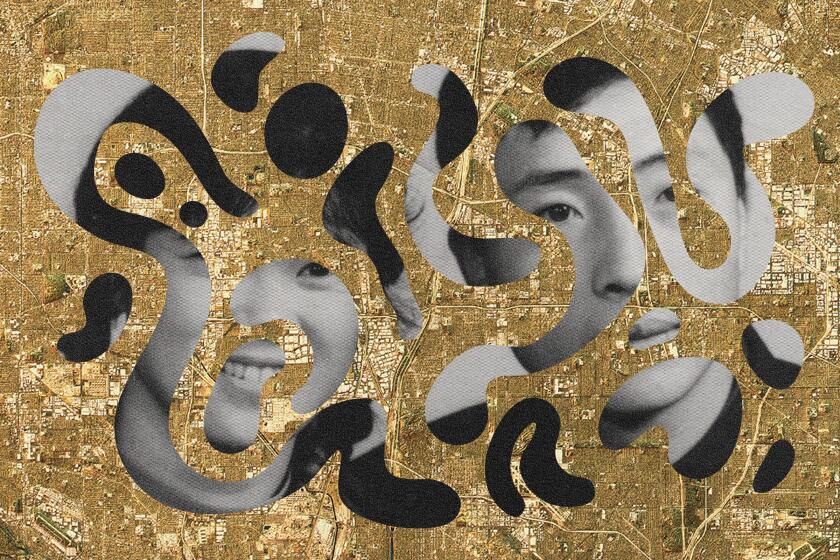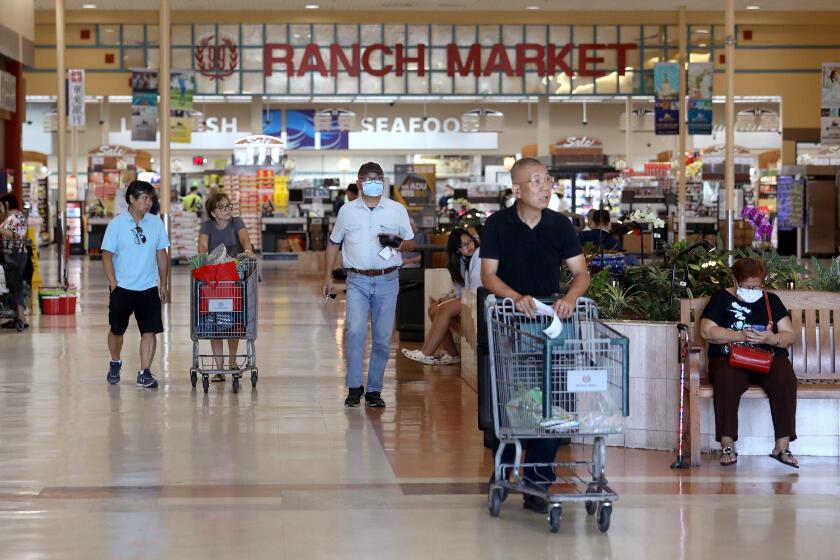Opinion: San Gabriel Valley is where Asian immigrants go to never assimilate. I embrace that legacy

- Share via
I grew up in the San Gabriel Valley — also referred to as SGV or the 626 — an ethnoburb in Los Angeles County where Asian immigrants go to never assimilate. Immigrants in the 1970s, initially mostly Chinese, built our own ethnic economy and ecosystem in SGV, with Chinese banks, grocery stores and hair salons, and Chinese-language schools on Saturday mornings for ABC (American-born Chinese) children. I grew up with two Wing Hop Fung retailers a 10-minute drive away from our one-story, three-bedroom home in the ethnoburb.
Wing Hop Fung was where I fabricated stories in my head about my mom being a Chinese herb witch as I watched her gather pungent, brightly colored seeds and plants to slow cook medicinal stews that would restore my yin and “undo the effects of all the fried chicken and pizza I ate at Jessica’s birthday party last weekend.” Dr. Lee provided psychiatry services in Mandarin, Cantonese and Toisan down the street. The Chinese Baptist church held worship services, Sunday school and weekly Bible study in English, Mandarin and Cantonese around the corner. 99 Ranch, Quickly and King Hua for the best dim sum outside of Hong Kong were all in our ZIP Code. Across the street from King Hua was Costco, which carried mooncakes, lap cheong and dehydrated sea cucumber in bulk (hoarding dehydrated sea cucumber is apparently a love language of immigrant dads).
Everything we needed was in the ethnoburb. Even so, when I was younger, naive and presumptuous, I found it embarrassing, “too ethnic.” I didn’t see how it told a story of resistance and rebirth, for Southern California and my family.
The Los Angeles Times analyzed 40 years of data from the census, charting the growth of Asian American and Pacific Islander communities across Los Angeles County.
From the beginning of World War II until the 1960s, Monterey Park, the origin of the San Gabriel Valley as an ethnoburb, prospered as one of the most affordable white suburban communities. The wartime economy brought transplants from across the country to Southern California, and Monterey Park became an emerging site of comfortable single-family homes and manicured green lawns. Postwar Monterey Park remained predominantly white but began to draw upwardly mobile Mexican, Japanese and Chinese Americans from different ethnic enclaves around Los Angeles, including East Los Angeles, the Westside and Chinatown.
In a time of charged debate and political struggle around race, segregation and housing rights in California and across the nation, Asian Americans and Mexican Americans approached home buying in Monterey Park cautiously by gathering intel from intra-ethnic networks and assessing the attitudes of local real estate agents. It helped that many of those looking to buy homes in Monterey Park were second- or third-generation immigrants: educated, acculturated and pursuing the dream of suburban life. Because they had social and financial capital and were few enough in numbers, they were perceived as less threatening to existing white political, institutional and cultural dominance in Monterey Park.
However, many of them still experienced racial discrimination at the time in their increasingly integrated social worlds. And Black Americans continued to face overt and violent resistance to home buying and integration. Geographer Wendy Cheng notes in her book “The Changs Next Door to the Díazes: Remapping Race in Suburban California” that anti-Black racism allowed Asian American and Mexican Americans to purchase homes and settle in Monterey Park, while Black Angelenos were continually hyper-segregated in South Central Los Angeles and precluded from buying in the suburbs.
This growing demographic backed Kamala Harris. But Democrats lost ground with them, as happened nationwide.
White suburban residents went to great lengths to exclude Black Americans from moving in, while slowly (begrudgingly) allowing Asian Americans and Mexican Americans to take up residence. In 1960, white residents made up 85.6% of Monterey Park, Latinos 11.6%, Asian Americans 2.8% and Black Americans 0.04%. By 1970, Monterey Park became the first ethnically diverse middle-class suburb in the country, with white people holding a majority at 50.5%, Latinos at 34%, Asian Americans at 15.3% and Black Americans hovering at 0.2%.
In the 1990s, my popo, who was in her 70s, relocated from Hong Kong to join us in San Gabriel. As she and her husband prepared to retire and settle down in Hong Kong, he instead decided to start a new family with a woman decades younger with whom he’d had a secret affair for almost 10 years. Without options and overwhelmed by shame, my popo left her home, her apartment where she had raised three children with her ex-husband, and her mah-jongg group in Hong Kong to live with us. She started over in a foreign place where she couldn’t speak the language, didn’t have peers and couldn’t get around. She was isolated and heartbroken.
With barely a kindergarten education, her life ambition had been to become a wife and a mother. In true Cantonese matriarch fashion, she bragged incessantly to her social circles about her husband’s and children’s accomplishments. Now, with three adult children with families of their own, she was not needed as a mother, no longer a wife and shamed by her community. When I was a child, she would insist, “Your popo has become a useless nothing.”
It perplexed me because I never saw her that way. Getting left by her husband did not turn out to be the end of her story.
How new arrivals remade the east San Gabriel Valley — and assimilated in it.
With the safety net of the ethnoburb, my popo rebuilt. After living with us for a few years, she moved into her own one-bedroom apartment on Main Street in neighboring Alhambra. She walked to 85 Degrees everyday, where they rang a cowbell whenever fresh baos came out of the oven. She made friends with Cantonese neighbors in her building, and they started their own mah-jongg group at which they would debrief the latest episode of whichever Cantonese drama had aired on TVB the previous night. She found a Cantonese church and got baptized. She never learned English. She drove recklessly in the 99 Ranch parking lot and didn’t care. She may have confirmed a few stereotypes, but the ethnoburb saved her. She stayed unapologetically herself through the upheavals of divorce and displacement. In the safety net of SGV, she got her groove back.
Sometimes my mom would take my popo out to go window-shopping in Beverly Hills and they would drag me along. For me as a child, Popo outside of the ethnoburb was a frightening, multisensory experience. She always brought her full self. She was large and in charge. She tried to bargain and make deals. In Cantonese. At Saks. Her voice and presence were always loud, even and especially when we were the only Asians around. You don’t speak Cantonese? Too bad and sit tight: 626 or 90210, my popo did not code switch.
I, on the other hand, started my PhD in code switching when I was 9, after transferring to an uppity, predominantly white private school. I saw Popo as an unassimilable tornado that left me in the dust, embarrassed and flustered.
Now, having moved away from the San Gabriel Valley for over 10 years to self-actualize in more “interesting” spaces, I find myself longing to go back. Paying exorbitant rent to live somewhere trendy is overrated and unsustainable. I want Asian strip malls, I want Hong Kong cafes and I want my child to grow up hearing Cantonese regularly and know that we’re not yelling; that’s just our default volume.
As my popo did, I embrace my ethnoburb — in all of its limitations, possibilities and unassimilability.
Bianca Mabute-Louie is a sociologist and the author of the forthcoming book “Unassimilable: An Asian Diasporic Manifesto for the 21st Century,” from which this piece is adapted, copyright 2025 by Bianca Mabute-Louie. To be published by Harper, a division of HarperCollins Publishers.
More to Read
A cure for the common opinion
Get thought-provoking perspectives with our weekly newsletter.
You may occasionally receive promotional content from the Los Angeles Times.













